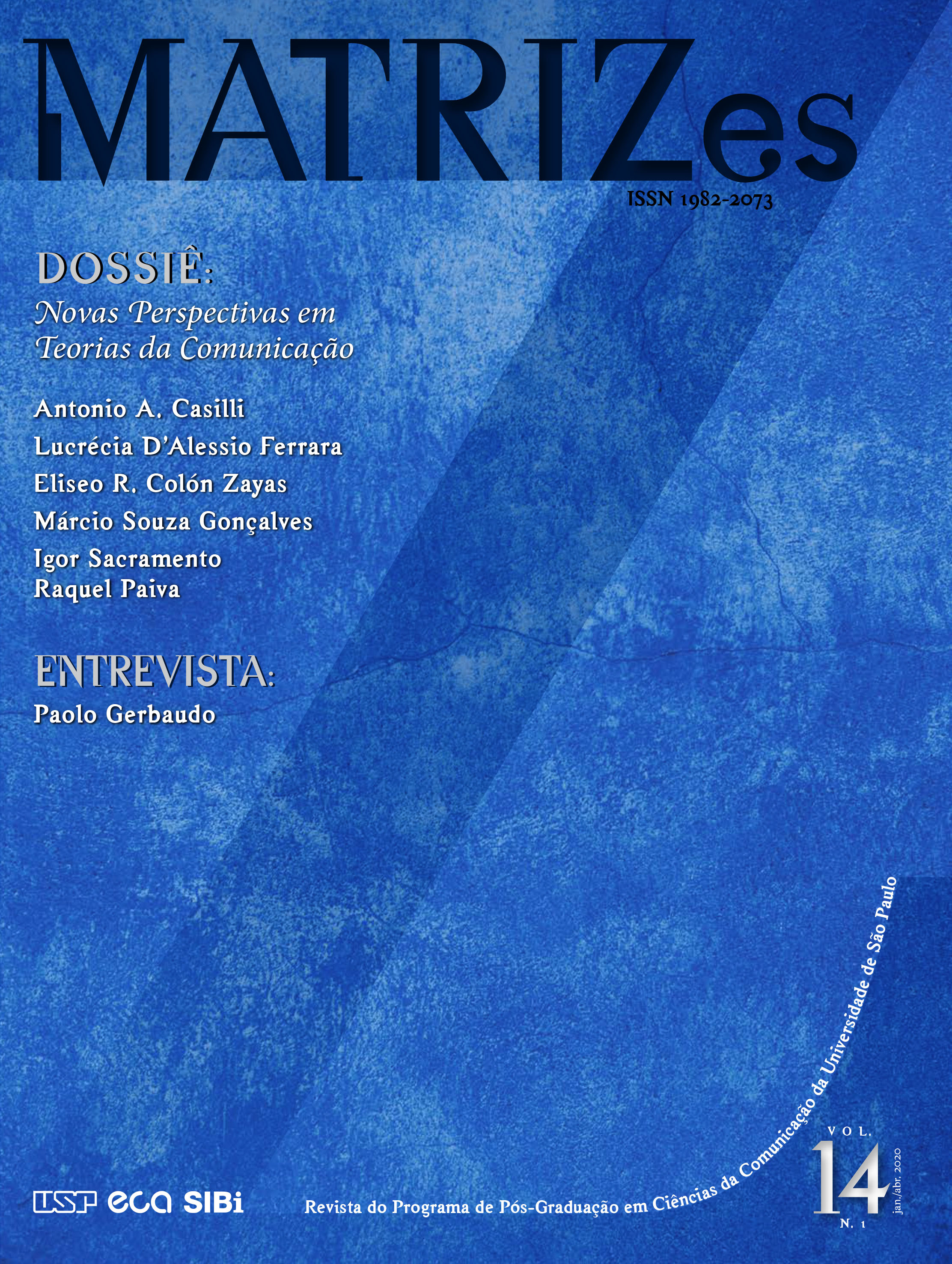Towards a gambiarra epistemology: invention, complexity and paradox in digital technical objects
DOI:
https://doi.org/10.11606/issn.1982-8160.v14i1p173-192Keywords:
Gambiarra, digital technical objects, games, complexityAbstract
By associating processes of constitution of digital objects to the concept of gambiarra, we aim to uncover the modes of existence that render the gambiarra as a crucial operator in the relationship between techniques, bodies and society. The aesthetic, political, and cognitive dimensions of the concept form an alternative version of technicity that allows us to understand the complex and even paradoxical aspects of digital sociotechnical formations. The empirical demonstration of these ideas will take place in three levels: the redirection of capacities of processing in video game consoles and video cards; the reconfiguration of software and user interfaces; and the resulting invention of rhythms and ways of seeing, feeling and acting in video games.
Downloads
References
Bruno, F. (2017). Objetos técnicos sem pudor: Gambiarra e tecnicidade. Revista Eco-Pós, 20(1), 136-149. doi: https://doi.org/10.29146/eco-pos.v20i1.10407
Clark, A. (2001). Mindware: An introduction to the philosophy of cognitive science. Nova York, NY: Oxford University Press.
De, N. (2019, 29 de janeiro). AMD cites ‘absence’ of GPU sales to crypto miners in Q1 estimate. Coindesk. Recuperado de https://bit.ly/34iZUdr
Delanda, M. (2005). Intensive science and virtual philosophy. Londres, Inglaterra: Continuum. (Obra original publicada em 2002)
Galloway, A. (2012). The interface effect. Cambridge, Inglaterra: Polity Press.
Grusin, R. (2015). Radical mediation. Critical Inquiry, 42(1), 124-148. doi: https://doi.org/10.1086/682998
Guattari, F. (2006). Caosmose: Um novo paradigma estético. São Paulo, SP: Editora 34.
Hardt, M., & Negri, A. (2001). Império. Rio de Janeiro, RJ: Record.
Hardt, M., & Negri, A. (2005). Multidão: Guerra e democracia na era do Império. Rio de Janeiro, RJ: Record.
Hardt, M., & Negri, A. (2016). Bem-estar comum. Rio de Janeiro, RJ: Record.
Hennion, A. (2010). Loving music: From a sociology of mediation to a pragmatics of taste. Comunicar, 17(34), 25-33. doi: https://doi.org/10.3916/C34-2010-02-02
Hofstadter, D. (1979). Gödel, Escher, Bach: An eternal golden braid. Nova York, NY: Basic Books, Inc.
Hui, Y. (2016a). On the existence of digital objects. Minneapolis, MN: University of Minnesota Press.
Hui, Y. (2016b). The question concerning technology in China: An essay in Cosmotechnics. Falmouth, Inglaterra: Urbanomic Media.
Johnson, S. (2001). Cultura da interface: Como o computador transforma nossa maneira de criar e comunicar. Rio de Janeiro, RJ: Zahar.
Jørgensen, K. (2013). Gameworld interfaces. Cambridge, MA: MIT Press.
Kastrup, V. (2007). A invenção de si e do mundo: Uma introdução do tempo e do coletivo no estudo da cognição. Belo Horizonte, MG: Autêntica.
Kastrup, V. (2008a). A cognição contemporânea e a aprendizagem inventiva. In V. Kastrup, S. Tedesco, & E. Passos, Políticas da cognição (pp. 93-112). Porto Alegre, RS: Sulina.
Kastrup, V. (2008b). Autopoiese e subjetividade: Sobre o uso da noção de autopoiese por G. Deleuze e F. Guattari. In V. Kastrup, S. Tedesco, & E. Passos, Políticas da cognição (pp. 46-63). Porto Alegre, RS: Sulina.
Krapp, P. (2011) Noise channels: Glitch and error in digital culture. Minneapolis, MN: University of Minnesota Press.
Lakoff, G., & Johnson, M. (1999). Philosophy in the flesh: The embodied mind and its challenge to Western thought. Nova York, NY: Basic Books.
Lapoujade, D. (2016). Deleuze: Los movimientos aberrantes. Buenos Aires, Argentina: Cactus.
Massumi, B. (2002). Parables for the virtual: Movement, affect, sensation. Durham, NC: Duke University Press.
Mbembe, A. (2017). Critique of black reason. Durham, NC: Duke University Press.
Mignolo, W. (2011). The darker side of Western Modernity: Global futures, decolonial options. Durham, NC: Duke University Press.
Norman, D. (1993). Things that make us smart. Cambridge, MA: Perseus Books.
Nvidia plays the diversification game. (2019, 23 de fevereiro). The Economist. Recuperado de https://econ.st/2wl7KXJ
Oliveira, L. A. (2003). Biontes, bioides e borgues. In A. Novaes (Org.), O homem máquina: A ciência manipula o corpo (pp. 139-173). São Paulo, SP: Companhia das Letras.
Pelbart, P. P. (2017). O avesso do niilismo: Cartografias do esgotamento. São Paulo, SP: n-1 edições.
Philip, K. (2015, 12 de março). Pirate copying, Jugaad economics: Postcolonial tech and developmental leapfrogging [arquivo de vídeo]. Recuperado de https://bit.ly/2RjAvLx
Rosas, R. (2007). Gambiarra: Alguns pontos para se pensar uma tecnologia recombinante. Caderno Videobrasil, 2(2), 36-52. doi: https://doi.org/10.22409/gambiarra.v1i1.29620
Simondon, G. (2009). The position of the problem of ontogenesis (G. Flanders, Trad.). Parrhesia Journal, (7), 4-16.
Simondon, G. (2017). On the mode of existence of technical objects. Minneapolis, MN: Univocal.
Singh, P. (1985). The so-called Fibonacci numbers in ancient and medieval India. Historia Mathematica, 12(3), 229-244. doi: https://doi.org/10.1016/0315-0860(85)90021-7
Sodré, M. (2014). A ciência do comum. Petrópolis, RJ: Vozes.
Souriau, É. (2015). The different modes of existence. Minneapolis, MN: Univocal.
Stengers, I., & Latour, B. (2015). The sphinx of the work. In É. Souriau. The different modes of existence (pp. 11-94). Minneapolis, MN: Univocal.
The PlayStation powered super-computer. (2010, 4 de setembro). BBC. Recuperado de https://bbc.in/2JMLb0Y
Varela, F., Thompson, E. T., & Rosch, E. (2001). A mente corpórea: Ciência cognitiva e experiência humana. Lisboa, Portugal: Instituto Piaget.
Viveiros de Castro, E. (2013). A inconstância da alma selvagem e outros ensaios de antropologia (5a ed.). São Paulo, SP: Cosac Naify.
Zyga, L. (2010, 2 de dezembro). US Air Force connects 1,760 PlayStation 3’s to build supercomputer. Phys.org. Recuperado de https://bit.ly/34eghYY
Downloads
Published
Issue
Section
License
Copyright (c) 2020 MATRIZes

This work is licensed under a Creative Commons Attribution-NonCommercial-ShareAlike 4.0 International License.
Authors who publish in this journal agree to the following terms:
- Authors retain the copyright and grant the journal the right to first publication, with the work simultaneously licensed under the Creative Commons Attribution License (CC BY-NC-SA 4.0) which allows sharing of the work with acknowledgment of authorship and initial publication in this journal for non-commercial purposes.
- Authors are authorized to assume additional contracts separately, for non-exclusive distribution of the version of the work published in this journal (eg, publishing in institutional repository or as a book chapter), with acknowledgment of authorship and initial publication in this journal.






















